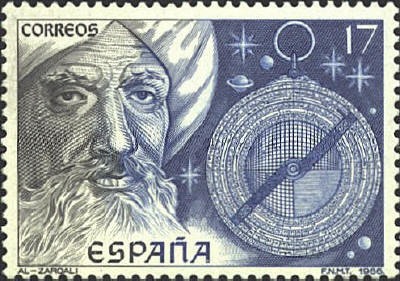The astrolabe was known by the
sixteenth century. The marine astrolabe is based on the astronomical
astrolabe. It is very heavy and, in use, is suspended from a strong
swivel thumb-ring. The sights line up the pointer arm with a star or
the sun, and the angle is read on the outer ring.

The stamp below features
al-Zarqali of Cordoba, a geometer, astronomer and maker of
instruments. He produced a set of trigonometric tables for use in
astronomy.

The
astrolabe can either be sighted directly at the sun, or the shadow of
the sun can be measured indirectly. The illustration is from Willem
Blaeu's The Light of Navigation, 1612.

The problem with these instruments is that the navigator may have to
look directly into the sun, with the result that over time eyes are
damaged. Some people say this is how pirates came to wear their famous
black patches – they went blind staring at the sun!

"The Persian mathematician and astronomer Jamshid al-Kashani (or
al-Kashi) (d. 1429) made extensive calculations with decimal fractions
and established a notation for them, using a vertical line to separate
the integer and fractional parts. A prodigious calculator, he
determined π to 16 decimal places and obtained a very precise value
for the sine of 1°, from which many other trigonometrical values can
be determined."
Robin J. Wilson, Stamping through Mathematics,
Springer-Verlag, 2001, p. 26


 |
